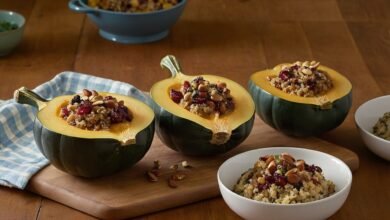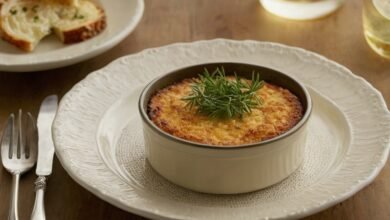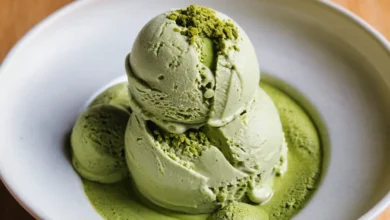Perfectly Pan-Fried Noodles: A Guide to Crispy, Flavorful Asian-Style Noodles at Home

Pan-fried noodles are a beloved staple in Asian cuisine, known for their irresistible combination of crispy edges and soft, chewy centers. Whether it’s the rich flavors of soy sauce, the caramelized crunch, or the variety of fresh toppings that can be added, pan-fried noodles make for a versatile and satisfying dish that can be enjoyed any time of the day. These noodles can be made in countless styles, with each Asian culture putting its own spin on the recipe, from Cantonese chow mein to Japanese yakisoba and Korean jajangmyeon.
In this guide, we’ll walk you through everything you need to know about pan-fried noodles, from choosing the right noodles to key ingredients and cooking tips. Discover how to make this flavorful, restaurant-quality dish at home that’s perfect for any craving!
What Are Pan-Fried Noodles?
Pan-fried noodles are typically made by first boiling the noodles, draining them, and then frying them in a hot skillet or wok until they reach a golden-brown, crispy texture. They’re often stir-fried with vegetables, meats, or seafood and coated in a savory sauce. The frying technique brings out the noodles’ unique texture, with crispy edges and tender insides.
The key to pan-fried noodles is achieving the perfect balance of crispy exterior and soft center. This can be done with a range of noodle types and combinations of sauces and toppings, making it easy to customize to your taste.
Types of Noodles for Pan-Frying
- Chow Mein Noodles: These thin, yellow noodles are commonly used in Chinese cuisine and work well for a classic pan-fried noodle dish.
- Rice Noodles: Light and slightly chewy, rice noodles are often used in Thai and Vietnamese dishes and are an excellent gluten-free option.
- Udon Noodles: Known for their thick, chewy texture, udon noodles are ideal for hearty Japanese-style stir-fries.
- Ramen Noodles: While traditionally used in soup, ramen noodles add a unique twist when pan-fried and pair well with savory sauces.
- Soba Noodles: Made from buckwheat, soba noodles bring an earthy flavor and work well for healthier pan-fried options.
Frequently Asked Questions About Pan-Fried Noodles
- How do you keep pan-fried noodles from sticking? The key is to use enough oil and let it heat up before adding the noodles. Using a non-stick skillet or wok is also helpful. Once the noodles are added, avoid stirring them too much, allowing them to develop a crispy crust.
- What sauce goes well with pan-fried noodles? Classic soy sauce, oyster sauce, hoisin sauce, and sesame oil make for delicious, flavorful coatings. You can also try chili paste or garlic sauce for an extra kick.
- Can I make pan-fried noodles gluten-free? Yes, using rice noodles or gluten-free soy sauce will make this dish gluten-free without sacrificing flavor.
- How do I achieve a restaurant-quality crispy texture? Ensure that the noodles are dry after boiling, use high heat, and avoid crowding the pan. Cooking in batches can help if you’re making a larger quantity.
- What toppings work best for pan-fried noodles? Popular toppings include sliced bell peppers, shredded cabbage, carrots, mushrooms, onions, scallions, and proteins like chicken, shrimp, beef, or tofu.
How to Make Pan-Fried Noodles at Home
Ingredients
- 8 oz noodles of choice (e.g., chow mein, ramen, or rice noodles)
- 2 tbsp vegetable oil or sesame oil
- 1 cup mixed vegetables (carrots, bell peppers, cabbage)
- 1/2 cup protein (chicken, beef, shrimp, or tofu), sliced thin
- 1 clove garlic, minced
- 1 tbsp soy sauce
- 1 tbsp oyster sauce (optional for added flavor)
- 1 tsp hoisin sauce
- 1 tsp sesame oil (for flavor)
Instructions
- Boil the Noodles: Start by cooking the noodles according to the package instructions. Drain them well and set them aside. For extra crispiness, pat the noodles dry with a paper towel.
- Prepare the Sauce: In a small bowl, mix together the soy sauce, oyster sauce, hoisin sauce, and sesame oil. Set aside.
- Heat the Oil: Add 1 tablespoon of oil to a large skillet or wok and heat it over medium-high heat. Once the oil is hot, add the noodles and press them down into the pan. Let them fry undisturbed for about 3–4 minutes, or until the bottom is golden and crispy.
- Add Vegetables and Protein: Push the noodles to one side of the pan and add the remaining oil. Sauté the garlic until fragrant, then add the vegetables and protein of choice. Stir-fry for 3–5 minutes or until the protein is cooked through and the vegetables are tender.
- Combine and Add Sauce: Pour the prepared sauce over the noodles and vegetables, tossing everything together. Stir well until the noodles are evenly coated in the sauce and continue frying for 1–2 minutes for extra crispiness.
- Serve: Transfer the pan-fried noodles to a serving plate, garnish with scallions or sesame seeds if desired, and enjoy!
Popular Variations of Pan-Fried Noodles
- Cantonese Style: Known for its savory soy-based sauce, this style includes stir-fried vegetables, meat, and crispy noodles for a traditional Chinese flavor.
- Thai Pad See Ew: This Thai version uses wide rice noodles and a sweet-savory sauce made with soy sauce, oyster sauce, and sugar, often paired with Chinese broccoli and egg.
- Japanese Yakisoba: Featuring yakisoba noodles with a tangy, slightly sweet sauce, this version often includes cabbage, pork, and carrots.
- Korean Jjolmyeon: Known for its chewy noodles and spicy sauce, jjolmyeon offers a spicier, Korean-inspired take on pan-fried noodles.
Health Benefits of Pan-Fried Noodles
While pan-fried noodles may seem indulgent, they can be made in a health-conscious way by controlling ingredients and oil content. Choosing buckwheat or rice noodles and incorporating plenty of vegetables adds fiber, while proteins like tofu or shrimp provide essential amino acids and nutrients.
Soy sauce and other ingredients commonly used in the dish are rich in antioxidants, supporting immune health. Additionally, noodles themselves offer a quick source of energy, making this dish a balanced option when combined with vegetables and proteins.
Conclusion
Pan-fried noodles are a delightful, flavorful dish that can be adapted to suit any taste preference. Whether you’re looking for the crispy textures of Cantonese chow mein or the spicier notes of Thai pad see ew, pan-fried noodles provide endless opportunities to explore Asian flavors at home. By following the tips above and experimenting with different sauces and toppings, you can easily create restaurant-quality pan-fried noodles in your own kitchen.
Embrace the art of pan-fried noodles, and experience how this dish transforms simple ingredients into a delicious, satisfying meal every time!





